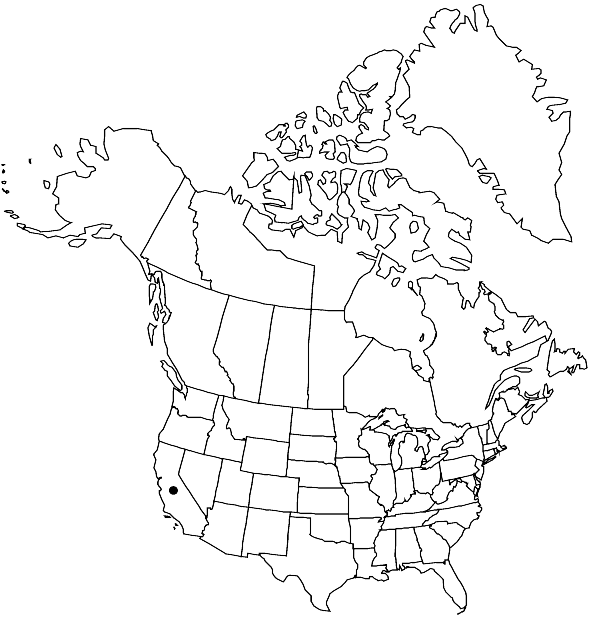Difference between revisions of "Grimmia shastae"
Grimmias, 208. 2003 (as shastai),.
FNA>Volume Importer |
imported>Volume Importer |
||
| (6 intermediate revisions by 2 users not shown) | |||
| Line 22: | Line 22: | ||
|distribution=Calif. | |distribution=Calif. | ||
|discussion=<p>Of conservation concern.</p><!-- | |discussion=<p>Of conservation concern.</p><!-- | ||
| − | --><p>Grimmia shastae is known only from Mt. Shasta. Its discovery demonstrates that the bryoflora of California is still not fully known. It also shows that the state is exceptionally rich in endemic species of Grimmia: G. mariniana, G. nevadensis, G. serrana, and G. shastae. Because of its abundantly present gemmae on the adaxial surface of the distal lamina, the latter is not likely to be confused with any other species of the genus. While gemmae are not rare in Grimmia, they are usually produced on leaf tips (G. anomala, G. hartmanii), on the abaxial side of the leaf (G. torquata, G. trichophylla), or in leaf axils (G. trichophylla, G. muehlenbeckii). In no other Grimmia species are gemmae produced in clusters on the surface of the adaxial lamina at the distal part of the leaf. The position of the species within the genus is not clear. Although its leaf form and areolation demonstrate its similarity to G. tergestina (subg. Litoneuron), the longitudinal plicae in the most distal leaves align it with G. caespiticia (subg. Guembelia). Sinuose laminal cell walls, characteristic of Grimmia, are only weakly present.</p> | + | --><p><i>Grimmia shastae</i> is known only from Mt. Shasta. Its discovery demonstrates that the bryoflora of California is still not fully known. It also shows that the state is exceptionally rich in endemic species of <i>Grimmia</i>: <i>G. mariniana</i>, <i>G. nevadensis</i>, <i>G. serrana</i>, and <i>G. shastae</i>. Because of its abundantly present gemmae on the adaxial surface of the distal lamina, the latter is not likely to be confused with any other species of the genus. While gemmae are not rare in <i>Grimmia</i>, they are usually produced on leaf tips (<i>G. anomala</i>, <i>G. hartmanii</i>), on the abaxial side of the leaf (<i>G. torquata</i>, <i>G. trichophylla</i>), or in leaf axils (<i>G. trichophylla</i>, <i>G. muehlenbeckii</i>). In no other <i>Grimmia</i> species are gemmae produced in clusters on the surface of the adaxial lamina at the distal part of the leaf. The position of the species within the genus is not clear. Although its leaf form and areolation demonstrate its similarity to G. tergestina (subg. Litoneuron), the longitudinal plicae in the most distal leaves align it with <i>G. caespiticia</i> (subg. Guembelia). Sinuose laminal cell walls, characteristic of <i>Grimmia</i>, are only weakly present.</p> |
|tables= | |tables= | ||
|references= | |references= | ||
| Line 31: | Line 31: | ||
-->{{#Taxon: | -->{{#Taxon: | ||
name=Grimmia shastae | name=Grimmia shastae | ||
| − | |||
|authority=Greven | |authority=Greven | ||
|rank=species | |rank=species | ||
| Line 45: | Line 44: | ||
|publication year= | |publication year= | ||
|special status= | |special status= | ||
| − | |source xml=https:// | + | |source xml=https://bitbucket.org/aafc-mbb/fna-data-curation/src/2e0870ddd59836b60bcf96646a41e87ea5a5943a/coarse_grained_fna_xml/V27/V27_359.xml |
|subfamily=Grimmiaceae subfam. Grimmioideae | |subfamily=Grimmiaceae subfam. Grimmioideae | ||
|genus=Grimmia | |genus=Grimmia | ||
Latest revision as of 21:25, 5 November 2020
Plants in hoary tufts, brownish green. Stems 0.3–1 cm. Leaves ovate to broadly oblong-lanceolate, 1–1.5 × 0.5–0.6 mm, larger towards stem tips, not keeled, frequently plicate in extreme apex, margins plane, incurved distally, long-awned, decurrent, costa weak proximally, broadened and deeply channeled distally; basal juxtacostal laminal cells rectangular, straight, with thin walls; basal marginal laminal cells rectangular, with thick transverse walls and thin lateral walls, hyaline in 3–4 rows; medial laminal cells short-rectangular, sinuose, slightly thick-walled; distal laminal cells 1-stratose with 2-stratose ridges, in apex entirely 2-stratose. Gemmae clusters of globular, brown, multicellular gemmae abundantly present on the adaxial side of the distal lamina. Sexual condition probably dioicous, gametangia not seen. Capsule unknown.
Habitat: Volcanic rock
Elevation: high elevations (3500 m)
Discussion
Of conservation concern.
Grimmia shastae is known only from Mt. Shasta. Its discovery demonstrates that the bryoflora of California is still not fully known. It also shows that the state is exceptionally rich in endemic species of Grimmia: G. mariniana, G. nevadensis, G. serrana, and G. shastae. Because of its abundantly present gemmae on the adaxial surface of the distal lamina, the latter is not likely to be confused with any other species of the genus. While gemmae are not rare in Grimmia, they are usually produced on leaf tips (G. anomala, G. hartmanii), on the abaxial side of the leaf (G. torquata, G. trichophylla), or in leaf axils (G. trichophylla, G. muehlenbeckii). In no other Grimmia species are gemmae produced in clusters on the surface of the adaxial lamina at the distal part of the leaf. The position of the species within the genus is not clear. Although its leaf form and areolation demonstrate its similarity to G. tergestina (subg. Litoneuron), the longitudinal plicae in the most distal leaves align it with G. caespiticia (subg. Guembelia). Sinuose laminal cell walls, characteristic of Grimmia, are only weakly present.
Selected References
None.
